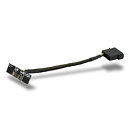Wednesday, December 22nd 2010

EVGA Intros Power Boost Gadget to Improve PCI-E Power Stability
EVGA released what it claims to be a handy little accessory that can increase PCI-Express slot power, improving overclocking stability of graphics cards installed. Called the EVGA Power Boost, the gadget is a tiny PCB that fits into the power-line notch of any PCI-Express slot (x1 thru x16), and draws in an auxiliary 12V line directly from the power supply unit. The little PCB draws in power from a standard Molex power connector, adding it to the motherboard's 12V line. EVGA also gave out a detailed HD video showing users exactly how to install the device, because inserting it into the wrong part of the PCI-Express slot will fry the motherboard. EVGA is asking $20 for it.


65 Comments on EVGA Intros Power Boost Gadget to Improve PCI-E Power Stability
Reminds me of this: www.cluboc.net/reviews/memory/ocz/booster/index.htm
and $20 .. cmon ... $3 maybe and they'd still make a ton of profit
if your (evga?) motherboard doesnt work right without it, then you bought a POS motherboard that is not engineered properly
I bet this works for those setups, but that begs the question, why not just do it right from the beginning?
This thing stabilizes your pci-e lanes...which each can pull 75W from the slot by spec....through a fan connector they didn't even bother to seperate the ground from the 12v line...yet warn about being a fire hazard for other reasons?
Yea....No.
While normally I'd be all for adding another 75W of available power (Yeah, yeah....50W 12v spec on a molex, but they're rated for 75W) I have a suspicion this doesn't do that at all. Besides, just like the fore-mentioned connector is rated at 50W while capable of 50% more, no doubt pci-e slots are massively over-specced as well, making this useless. While I don't know the electronic specifics of board-supplied pci-e power, let me break down why this is likely useless. PCIe is overbuilt.
Case in point, PEG connectors.
6-pin and 8-pin PEGs have the same amount of 12v wires. True story, 3 apiece, although in the 6-pin, one might as well be disconnected because it isn't needed. The 6-pin connector is rated at 8A (itself a safe spec), but the pci-e spec is 6.5A (75W). So each 12v line pulls 2ish amps max in a 6-pin plug...compared to a molex plug that is specced at twice that, and rated for three times as much. The 8-pin uses all three 12v lines, and pulls up to 4A apiece (150w/12v/3=4.16_A), the EXACT same as the molex spec, but uses an enormous amount of grounds. If you can subtract, you would say 5. You would be right. If you think that is overkill, you would be right.
Our pci-e power is fine and COMPLETELY fail safe already; bullshit peripherals like this make me sad.
EVGA was my fav brand... for a long time
Is that what this is targeted at?
And yet again, it seems to me they could've addressed this in the initial board design, tbh.
www.xtremesystems.org/forums/showthread.php?t=226942Yes only on the 4-way. They were the first to do this, but Asus and Gigabyte soon followed, but went as far as having two 4-pins.
*HINT* *HINT* evga *HINT* *HINT*
Edit:
just thinking about it if your good at soldering you could probably make one of these from a dead pcie graphics card
That is the first thing I thought of when I saw this.
The only use I see for this is using on the boards that have 3 or more PCI-E slots and don't provide a molex on the board to provide extra power to the slots. EVGA isn't the only boards guilty of this, I've seen ASUS do it too, and I believe even Gigabyte. I'm sure if you looked hard enough you could find boards from everyone that didn't have the extra molex connecter on the board actually. But $20 is a bit excessive for a tiny PCB and two wires solder onto it, as W1z said, $3 would still be a profit.